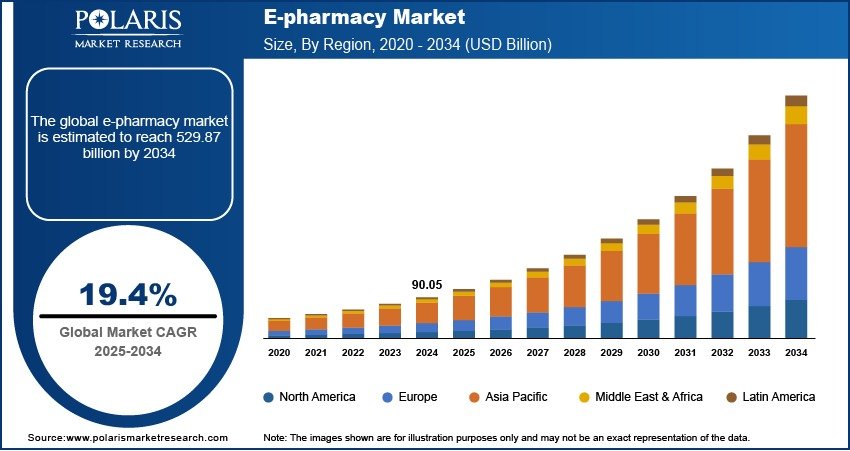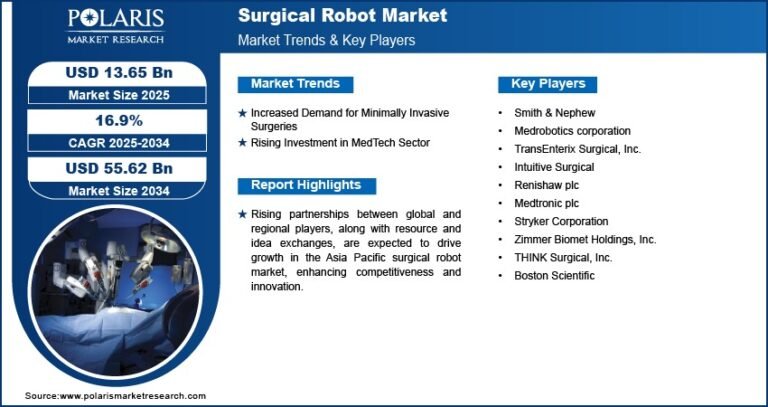E-Pharmacy Market Projected to Reach USD 529.87 Billion By 2034, Growing at a CAGR of 19.4%

The global E-Pharmacy market size was valued at USD 90.05 billion in 2024 and is anticipated to generate an estimated revenue of USD 529.87 billion by 2034 , according to the latest study by Polaris Market Research. The report also notes that the market exhibits a robust Compound Annual Growth Rate (CAGR) of 19.4% over the forecast period from 2025 to 2034 .
- Rise in Digital Healthcare Adoption: With increasing internet penetration and smartphone usage, consumers are shifting toward online platforms for medication purchases, especially in rural and underserved areas.
- Post-Pandemic Shift Toward Contactless Services: The preference for home delivery of medicines has surged post-pandemic, accelerating the adoption of e-pharmacies globally.
- Integration with Telemedicine Platforms: Many e-pharmacies now offer integrated services with teleconsultations, enabling users to consult doctors online and receive prescriptions directly on the platform.
- AI and Chatbot Integration: Companies are leveraging AI-driven tools such as chatbots and virtual assistants to enhance customer experience, provide medication reminders, and assist with order tracking.
- Expansion into Emerging Markets: E-pharmacies are expanding rapidly into developing economies where access to physical pharmacies is limited, supported by growing digital infrastructure and rising health awareness.
- Market size value in 2025 – USD 107.43 billion
- Revenue forecast in 2034 – USD 529.87 billion
- CAGR – 19.4% from 2025 – 2034
The e-pharmacy market encompasses online platforms that facilitate the sale and delivery of pharmaceutical products, including prescription drugs, over-the-counter medications, healthcare devices, and wellness products. The market has experienced rapid growth due to changing consumer behavior, increased demand for convenience, and advancements in digital health technologies. Additionally, regulatory support and the rise of mobile health applications have further propelled the expansion of the e-pharmacy industry. As governments across the globe recognize the importance of digital health solutions, the sector is poised for sustained growth during the forecast period.
https://www.polarismarketresearch.com/industry-analysis/e-pharma-market/request-for-sample
- Growing Demand for Online Medication Delivery: Consumers increasingly prefer the convenience of ordering medicines online and receiving them at their doorstep, particularly among elderly and chronically ill patients.
- Technological Advancements in Healthcare: The integration of AI,blockchain, and cloud-based systems in pharmacy operations enhances supply chain transparency, ensures drug authenticity, and improves patient safety.
- Rising Chronic Disease Burden: Increasing prevalence of lifestyle-related diseases such as diabetes, hypertension, and obesity is driving the need for regular medication, boosting the demand for online pharmacy services.
- Government Initiatives and Regulatory Support: Governments in several countries are introducing favorable policies and regulations to promote digital healthcare and ensure safe and secure online medicine sales.
- Expansion of Logistics and Cold Chain Infrastructure: Improved logistics networks, including temperature-controlled storage and last-mile delivery capabilities, are enabling efficient distribution of sensitive medications and vaccines through e-pharmacies.
- Regulatory and Legal Hurdles: Varying regulations across regions regarding online sale of medicines create compliance challenges for global players.
- Counterfeit Drug Concerns: Ensuring product authenticity and preventing the sale of counterfeit medicines remain significant concerns for both consumers and regulators.
- Data Privacy and Security Issues: Handling sensitive health data requires robust cybersecurity measures, which can be costly and complex to implement.
- Limited Internet Penetration in Rural Areas: Despite improvements, many remote areas still lack reliable internet access, limiting the reach of e-pharmacy platforms.
- Consumer Trust and Awareness: Lack of awareness about legitimate e-pharmacy platforms and skepticism around online transactions can hinder adoption in certain demographics.






